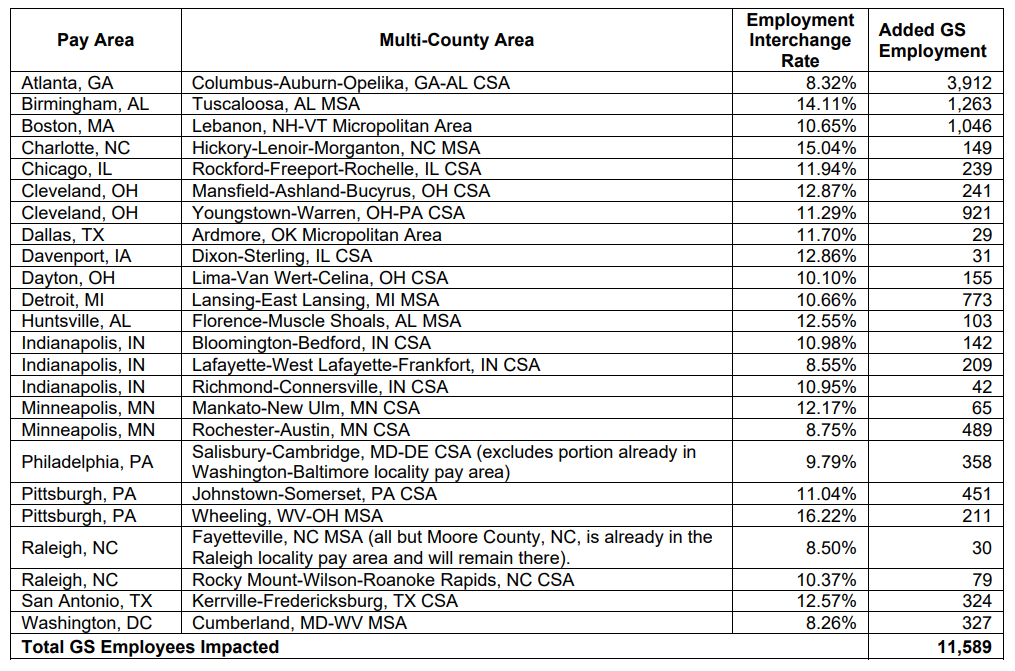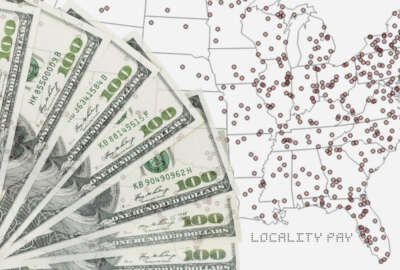
Breaking down a few key recommendations from the Federal Salary Council
Recommendations to expand pay localities, adjust requirements to add new localities and more from the Federal Salary Council.
The Federal Salary Council has reported that federal wages still lag significantly behind the private sector, but that’s not the only update from the council with the potential to impact pay for tens of thousands of federal employees.
Many of the working group’s recommendations centered on adding and expanding a few different pay localities, as well as changing how many federal employees must be working in an area to qualify for establishing a new pay locality.
“These recommendations would result in roughly 32,950 General Schedule (GS) employees being re-designated from the ‘Rest of U.S.’ to a separate locality pay area,” an Aug. 5 council document stated.
In particular, the council recommended adding a stipulation that any newly proposed pay locality must have a 7.5% employment interchange rate for locations in Metropolitan Statistical Areas (MSAs) and Combined Statistical Areas (CSAs). For areas that aren’t MSAs or CSAs, as well as locations surrounded by different pay localities, the council recommended establishing a 20% interchange rate.
For a locality to count as an MSA, it must have at least one “urbanized area” of 50,000 or more inhabitants, the Office of Management and Budget defined. CSAs are areas adjacent to MSAs.
The council, tasked with recommending annual adjustments to locality pay for federal employees, met on Aug. 5 and adopted input from a working group composed of leaders from several federal unions.
“These recommendations would put additional money into the hands of federal employees whose pay lags behind their coworkers,” American Federation of Government Employees National President Everett Kelley, a member of the council’s working group, said in an Aug. 5 press statement.
The council also recommended removing the lower limit of having at least 2,500 GS employees in a given area to qualify for consideration as its own pay locality. Altogether, the recommendations would have the potential move roughly 15,400 GS employees from the “Rest of U.S.” locality, to a separate pay locality.
Another recommendation from the working group that the council adopted followed an update that OMB made to its map of MSAs and CSAs. The new recommendation would add any areas previously included on the map to the updated map, and would not remove any areas that were not included on the updated map.
Other recommendations from the council would add the following areas to existing pay localities, impacting nearly 11,600 GS employees:

You can find all of the council’s recommendations here.
None of the recommendations, though, are final. First, the president’s pay agent, a three-person panel comprising leaders from the Labor Department, the Office of Personnel Management and OMB, must consider and approve the recommendations.
The Federal Salary Council didn’t make any recommendations last year, because at the time, President Joe Biden had not yet picked nominees for the three politically appointed seats on the council. In March, Biden appointed three members to the council, including Stephen Condrey to serve as chairman. Condrey previously served as chairman of the council for former President Barack Obama, from 2010 to 2017. The other two appointed members are Janice Lachance, a former OPM director, along with Jared Llorens.
Where does locality pay come from?
Each year, GS employees receive two pay adjustments: one for base pay, and another for locality pay.
In 1990, Congress passed the Federal Employee Pay Comparability Act (FEPCA), which intended to eliminate a growing pay gap between non-federal and civil service salaries. Currently, pay localities are broken into 53 areas across the country, along with a “Rest of U.S.” category.
FEPCA authorized implementing the full pay raise that’s needed to reduce the pay gap between federal and non-federal salaries down to a 5% difference. But, neither previous administrations nor the current administration have ever adopted the full pay adjustments that FEPCA allows.
The council calculates the pay disparity based on wages only, with the most recent gap showing that federal employees’ pay falls behind the private sector, on average, by 22.47%. But, some economists, as well as the Congressional Budget Office, have said that when considering the value of benefits, federal employees are actually paid more than their non-federal counterparts.
Rather than going by cost of living for a given location, changes to locality pay are based on information from the Bureau of Labor Statistics, which measures non-federal versus federal pay in a given labor market, for employees who do similar work in the same area.
The Federal Salary Council makes recommendations each year to adjust the breakdown of pay localities for GS employees. Then, the president’s pay agent reviews the recommendations and determines whether to implement them.
Biden did not specify the breakdown of the proposed federal pay raise for 2023, but typically, 0.5% of the total percentage is reserved for pay locality adjustments. If that holds true, that means the 4.6% across-the-board proposal would indicate a 4.1% base pay increase, plus 0.5% distributed for locality pay.
Copyright © 2024 Federal News Network. All rights reserved. This website is not intended for users located within the European Economic Area.
Drew Friedman is a workforce, pay and benefits reporter for Federal News Network.
Follow @dfriedmanWFED





